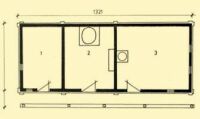| Regional Differences in Hungarian Architecture | CONTENTS | Western and Central Transdanubia |
Southern Transdanubia
This is the hilly, at one time largely forested area that lies largely south of the Balaton and stretches to the Dráva. It is thickly settled with villages, mostly small in population, in some of which the double inner-lot type of settlement can be demonstrated until the most recent times. Most of the villages, excepting the settlement type villages of the 18th century, are agglomerations. A significant part of these were changed into settlements along streets and partly into settlements with ribbon holdings when the fields and villages were officially regulated in the first half of the 19th century. A significant part of the agricultural work used to be done in the threshing yard, but already in the last century this practice was sporadical, though it could be still observed between the two world wars. Only the most valuable and most important part of the produce, especially that for human consumption, was kept in the yard and in the house.
Zádor, Baranya County. 19th century.
1. Pantry. 2. Kitchen. 3. Dwelling room
Szalafő, Pityerszer, Vas County
In earlier times building material was primarily wood, but undoubtedly wattle on a foundation of beams always had great importance. The building rested on a foundation of huge logs and its roof was covered almost exclusively with straw thatch. Reed thatch took the place of this along the Balaton and around rivers and swamps. Here the use of clay is newer in origin and the use of adobe has been spreading generally only for a century. The so-called karóköz building is known in Somogy and Baranya, where they build a frame of stakes for the wall. It appears that {175.} formerly they used sods in this area and even made ovens out of it. They fitted the cut-out pieces of sod into an oven shape, plastered them with clay on the outside, and pressed the surface with planks. When the clay dried they removed the planks and cut a hole in front for making fire and putting in bread.
Szalafő, Pityerszer, Vas County
We can explain the partitioning and ground-plan of the Southern Transdanubia house by the fireplace. Originally the house consisted of a single room, on one side of which stood the bank of the hearth (padika), round-, or in some places square-shaped, made of clay, on which they cooked in a copper cauldron hanging from a beam. Primarily the old people used this room, while the young folk spent the night in the separate bedchamber, located outside the house. This szenes ház, a house with an ember hearth, later on became, along with its open fireplace, a separate room attached to the house, but it kept its name. Its ancient origin is proved by the custom that asking for the girl’s hand took place in here for three consecutive days, and only afterward was the young man’s father and godfather led into the house. The fact that the two rooms have separate outdoor exits also shows that the two rooms originate from different times. At this degree of development, the room already had a closed oven, which was heated from the kitchen. As the development of the house continued they built one more room on the {177.} other side of the kitchen. This in many cases made unnecessary the separate bedchambers in the yard.
The one-roomed house with an ember fire is related to a Balkan type of house, which retained certain characteristics from the age of the Romans. The demonstrable connection with the Balkan house is manifested not only in the form of the fireplace, but in the implements belonging to it: baking bell, copper kettle, etc. At the same time the Hungarians influenced their southern neighbours by introducing the various forms of the tile stoves, and the house with a divided ground-plan. In Hungarian ethnographic literature they also call this kind of house, which preserves great antiquities, the Pannonian–Balkan form.
The largest farm buildings of this area are the barns or sheds, (see Ill. 10) placed both outside or inside the settlement. These are made of wattle and built on thick foundation logs. In the Ormánság, they built a stable onto one of the barns, a development probably of recent times. The huge wicker maize bins or lofts (kukoricakas) can be found in the entire area, but the most beautiful examples are in Somogy County (Ill. 84.).
| Regional Differences in Hungarian Architecture | CONTENTS | Western and Central Transdanubia |


